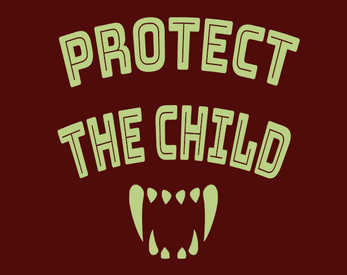Last night, I got a couple of my players together to try Protect the Child, a game by Mint Rabbit who you may also have come across as the person behind There’s a TTRPG for That on Tumblr.
Premise
The basic premise behind Protect the Child is that everyone in the party is a monster. The book later states that that can be more metaphorical, that the teeth and claws could be implied rather than literal. My group went literal.
These monsters find themselves in possession of a human child who they must protect and return to its parents. Because the kid is special and there is some group out there who wants to take the child for reasons (reasons your group will create).
One member of my group keeps creating “Wolf and Cub” characters, so I immediately sent a link to him when I first saw Mint talking about this game. It was decided that we needed to try it as soon as possible, but the whole “this child is in danger” goes explicitly against a Line for my normal group. So we did a small group game.
Presentation
As it exists in playtest form, the game is one Google Doc with the rules and one Google Spreadsheet with a playkit where you can type all your information in.
Google Spreadsheet as Virtual Tabletop actually worked surprisingly well during our session.
And please don’t let “Google Spreadsheet” turn you off, there’s clear design thought that went into putting this thing together. The sheet looks as good as a lot of the things I’ve seen from bigger companies, and best of all it’s functional for use in gameplay. We were literally sharing the sheet while chatting over things, taking turns filling in bits as they came up. It worked fantastic.
Things I Enjoyed
Though there’s no default setting for the game, with each group being left to interpret the premise as they see fit, the questions posed for world and character creation are incredibly evocative. Each one had my group not just filling in that information but jumping off on how that element would be connected to another.
And like I said, the playkit in Google Spreadsheet form worked beautifully for passing information around the table and all having our input and seeing the way the notes were taken to clarify anything that was unclear.
Things I Thought Needed Work
This is still a playtest, so it’s not a full book with things like a Table of Contents. As a GM who hasn’t played or run another Blades or Forged in the Dark game, there was a moment where we’d put together two characters and answered five questions about the world and I thought I was off to game play.
That was not the case, as we didn’t have the factions needed to quickly smash into each other like action figures in a child’s playroom and create the drama to drop the characters into.
The section discussing the faction creation was later in the document, just above a section titled “Running the Game”. I managed to scroll right past it between “Playing” and “Running”. I personally would have been helped if at somepoint during the initial setting questions, or during character creation, there were a sign post saying to go to the section.
The section itself was great, and had more of the evocative stuff that led to my players bouncing ideas off each other, it just wasn’t as clear that we needed to go there as it could have been.
Experiences
So with a late start to our session and some of the mistakes made during setting creation and needing to step back into setting creation, we didn’t get to the actual “Play”. That said, even just setting and character creation was a great experience and came with a lot of fun questions and a lot of fun discussions about what we wanted to see from the game.
I’d never used the “C.A.T.S” system for game expectations (Concept, Aim, Tone, Subject Matter). It really let us define from the start which parts of the game’s premise were most intriguing to us. We wanted to see a lot of the interplay between status quo and forced change coming from adolescence. We wanted to see that in a dark comedy form. Each of the characters has their own change thrust upon them by external forces that is going to mirror the child dealing with early adolescence. It led to much more coherent answers in the rest of the creation process.
Final Thoughts from this Session
Overall, I like this one. We’ll be coming back to it when we have a chance to actually play through with these characters.
I really like the way that the game has questions set up to help a group really dig into what they want out of it and to design their game specifically to get at those things.
The only negative I really saw in it is an organizational thing that would likely have been solved by me just reading the thing all the way through, or in a final version by just seeing “The World You Play In” as a section in the Table of Contents.
So if you, like my buddy, find yourself creating a ton of characters where the gruff mercenary is stuck with a kid now and doesn’t quite know what to do with them, you would probably like this one. Even just answering the questions is a fun time.
Link to Game
Protect the Child is available on itch.io from Mint-Rabbit. The playtest docs are Pay What You Want.

Leave a Reply